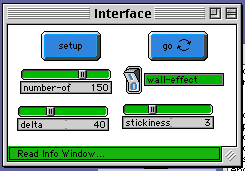
WHAT IS IT? ----------- This program models gas chromatography. Gas chromatography is a process of separation of chemicals based on surface interactions. The blue field imitates a porous medium and the red and green turtles are molecules which are pumped through the blue "absorber". Molecules in this model wander randomly downward. Each green molecule carries a variable called "stuck". Whenever a green molecule lands on a blue patch its "stuck" variable is set to "stickiness". Physically, this is caused by a number of factors: surface interaction, geometry and size of the molecule, etc. If stickiness is set to five the green molecule stays at the blue patch for five cycles, essentially slowing its downward motion compared to the red molecules. This leads to separation. Also this model attempts to demonstrate an important concepts called wall-effect. If there is some space near the walls then the molecules can get through these channels, which will drastically reduce the quality of separation. The empty space near the walls may result from bad quality of absorber or from inadequate stuffing. HOW TO USE IT ------------- First set the porosity of the blue absorber with a slider called NUMBER-OF-PORES. You can change the thickness of the absorbent layer with a slider named DELTA. The WALL-EFFECT switch turns the wall-effect on and off. Then push SETUP. Then press GO to run the model. The STICKINESS slider changes the stickiness parameter. The higher the value of stickiness the slower the green turtles move through absorbing layer. RUNNING the MODEL ----------------- The program works fastest when stickiness is between 3 and 7 and when porosity is over 100. If either of these parameters is small it might take too long for the green turtles to sip through the absorbing layer. THINGS TO NOTICE ---------------- Separation depends on porosity. If porosity is too small the absorbent gets contaminated and the process stops. If porosity is too high then there is not enough separation. Also wall effect reduces the quality of separation in a drastic way. THINGS TO TRY ------------- One could try to improve the plotting routine. In a real chromatograph there is only one output curve showing the rate at which molecules come out and a device called an integrater that tells the amount of matter that has come out. Try separating more than two gases. STARLOGOT FEATURES ----------------- Notice the routine that digs tunnels. It is very easy to implement parallel random walk algorithms with StarLogoT.